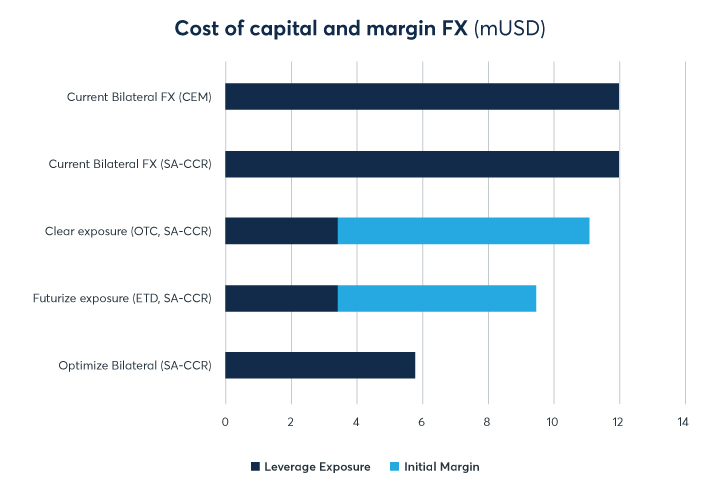The introduction of the new capital regulation, Standard Approach to Counterparty Credit Risk (SA-CCR), drastically changes the metrics used for deriving the capital cost. TriOptima has looked into how different market participants could choose to deal with it in practice.

For many years, under the Current Exposure Model (CEM), the capital costs have largely been driven by the total gross notional. Under SA-CCR, this shifts to using risk-based counterparty exposure instead. This is a rather fundamental change of methodology, which could have a huge impact on trading behavior, as well as post-trade portfolio optimization.
If we look specifically at the FX market, it differs from the rest of the financial markets in that it largely remains outside of the bilateral initial margin requirements introduced with the uncleared margin rules (UMR) a few years ago. Physically settled FX trades are exempt from UMR and thus do not attract any of the costs associated with funding bilateral initial margin (IM) for market participants.
To analyze how the industry could mitigate the cost of holding capital on balance sheets under SA-CCR, TriOptima conducted a study based on the trade population between the 20 largest banks in the seven largest currency pairs. In this study, we calculated the capital costs under the CEM and compared these with the costs under SA-CCR.
The first conclusion from the study was that the capital cost for the industry remained largely unchanged under the two regulations. For some banks, the cost was lower under SA-CCR, and for others, it was higher. In other words, there does not appear to be any automatic capital cost rebate as a result of SA-CCR.
We then analyzed the potential for reducing the bilateral exposures through different methods, with the goal being to reduce the capital cost under SA-CCR. The largest reduction of capital costs would be achieved through futurization of the trades (i.e., converting the OTC exposures into exchange-traded derivatives, or ETDs), or through clearing the OTC forwards. The study showed that either option would remove at least two thirds of the capital cost. However, in both cases, the trades would switch from being unmargined (as FX Forwards are not subject to UMR) to margined trades, thus incurring the additional IM expense would drastically limit the savings made when looking at the all-in cost.
The third alternative is to keep the FX forwards bilateral but optimize multilaterally. This means that bilateral delta exposure is redistributed between counterparties to minimize the total counterparty risk (and hence their capital cost), e.g., by moving an exposure facing one counterparty to instead face another counterparty where it offsets an outstanding risk, and hence reduces the total exposure across both counterparties. The netting in this case is not quite as efficient as with clearing and futurization, but residual exposures will remain bilateral and will thus not be subject to any additional cost of initial margin. That means the all-in cost of the portfolio would be significantly lower compared to the other two options.
The results of the different alternatives described above are highlighted in Graph 1.

Different market participants have different objectives based on their portfolio structure, IT infrastructure, etc., and we will therefore likely see a combination of different methods for tackling the new reality under SA-CCR, just like has historically been the case when capital regulations change. Some will use OTC clearing because it is the best fit, others will use futures. However, our conclusion is that we are not likely to see a mass-exodus from bilateral OTC trading in FX forwards, since the economic incentive simply is not there.
Even in the case of FX NDFs, which unlike FX forwards are bilaterally margined, the cleared volume falls well short of the total volume. Operational constraints, particularly in the prime broker space, have, to a significant degree, prevented trades from being cleared.
To efficiently manage post-trade optimization of their FX portfolios, market participants need to consider both the exposure under SA-CCR and under UMR. Thus, any post-trade optimization model that takes SA-CCR and UMR into account would seek to minimize both the total FX exposure and the FX exposure in scope for UMR.
In addition, there are several other metrics that incur different costs, including risk-weighted assets, gross notional outstanding, balance sheet usage, etc. If different metrics are managed and optimized in separate processes, it can quickly lead to sub-optimization when the benefit of improving one metric is offset by increased costs from unintended changes in other metrics. This means the optimization model needs to be able to take multiple different metrics into account simultaneously.
Furthermore, optimization services that redistribute or rebalance risk within a network is based on the idea that injecting an offsetting “hedge” transaction into an existing trading relationship can reduce the outstanding risk, and over time, the cost of capital from, for example, SA-CCR. However, by also including the trade population available for compression, the reduction of bilateral exposures can also be achieved by terminating transactions that contribute to the existing bilateral exposures. Combined, terminations and new trades together allow that reduction of gross notional is balanced against net exposure reduction, and the process can, as a result, accommodate all types of participants, regardless of whether they are sensitive to gross notional or not, and whether they can do terminations or not.
(Photo: Nils Johan Gabrielsen / Unsplash)
To find out more about TriOptima, click here or contact us at info@trioptima.com
As the world’s leading and most diverse derivatives marketplace, CME Group (www.cmegroup.com) enables clients to trade futures, options, cash and OTC markets, optimize portfolios, and analyze data – empowering market participants worldwide to efficiently manage risk and capture opportunities. CME Group exchanges offer the widest range of global benchmark products across all major asset classes based on interest rates, equity indexes, foreign exchange, energy, agricultural products and metals. The company offers futures and options on futures trading through the CME Globex® platform, fixed income trading via BrokerTec and foreign exchange trading on the EBS platform. In addition, it operates one of the world’s leading central counterparty clearing providers, CME Clearing. With a range of pre- and post-trade products and services underpinning the entire lifecycle of a trade, CME Group also offers optimization and reconciliation services through TriOptima, and trade processing services through Traiana.
All information contained herein (“Information”) is for informational purposes only, is confidential and is the intellectual property of CME Group Inc and/or one of its group companies (“CME”). The Information is directed to Equivalent Counterparties and Professional Clients only and is not intended for Non-Professional Clients (as defined in the Swedish Securities Market Law (lag (2007:528) om värdepappersmarknaden)) or equivalent in a relevant jurisdiction. This Information is not, and should not be construed as, an offer or solicitation to sell or buy any product, investment, security or any other financial instrument or to participate in any particular trading strategy. The Information is not to be relied upon and is not warranted, either expressly or by implication, as to completeness, timeliness, accuracy, merchantability or fitness for any particular purpose. All representations and warranties are expressly disclaimed. Access to the Information by anyone other than the intended recipient is unauthorized and any disclosure, copying or redistribution is prohibited without CME’s prior written approval. If you receive this information in error, please immediately delete all copies of it and notify the sender. In no circumstances will CME be liable for any indirect or direct loss, or consequential loss or damages including without limitation, loss of business or profits arising from the use of, any inability to use, or any inaccuracy in the Information. CME and the CME logo are trademarks of CME Group. TriOptima AB is regulated by the Swedish Financial Supervisory Authority for the reception and transmission of orders in relation to one or more financial instruments. TriOptima AB is registered with the US National Futures Association as an introducing broker. TriOptima holds a permit under Section 49A of the Israeli Securities Law, however TriOptima’s operations are not subject to the supervision of the Israel Securities Authority. This permit does not constitute an opinion regarding the quality of the services rendered by the permit holder or the risks that such services entail. TriOptima’s services are designed exclusively for Qualified Investors in accordance with Israeli law. For further regulatory information, please see www.cmegroup.com.
TriOptima AB. Registered Address: Mäster Samuelsgatan 17, 111 44 Stockholm, Sweden.
Org no.: 556584-9758.
Copyright © 2021 CME Group Inc. All rights reserved.












